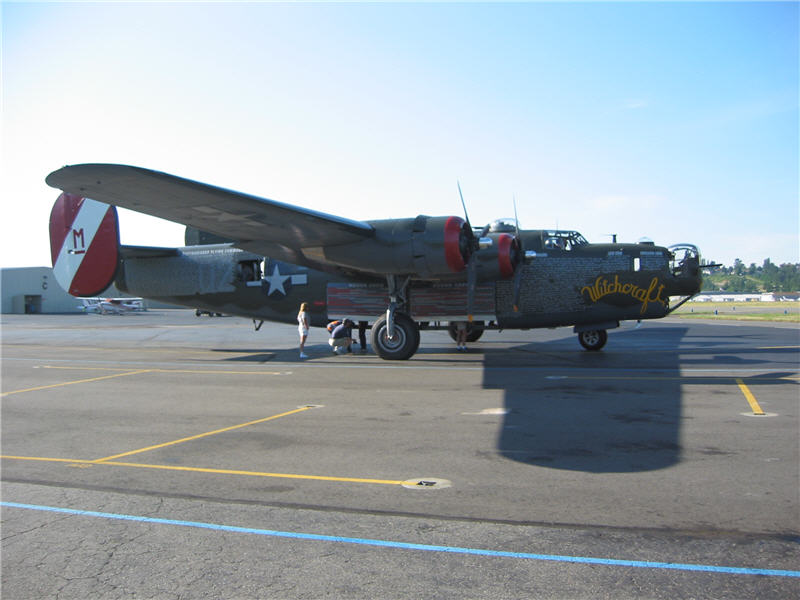
The Collings Foundation B-24, painted as Witchcraft.
The B-24 flew in every theater of WWII. There were more than 18,000 of them produced, more than any other US military aircraft and more than any other multi-engine bomber of any nation. Witchcraft was a B-24H in the 467th Bombardment Group, 790th Bombardment Squadron of the 8th Air Force. It flew in the 467th BG's first mission (April 10, 1944), its last mission (April 25, 1945), and 128 missions in between -- 130 missions in all, an 8th AF record.
There are many modern color depictions of Witchcraft, but they might have some inaccuracies. This document is an attempt to discover the correct historical colors and characteristics of the paint job on Witchcraft.
The Colling's Foundation B-24 is painted as Witchcraft and looks as follows. (As of September, 2008, it is the world's only remaining flying true B-24, as opposed to a conversion of another model. This B-24 tours the US each year, stopping at airfields around the country. Amazingly -- you can take a 20-minute ride on it for about US$425. It is an experience of a lifetime for WWII aviation enthusiasts. Here is what such a ride is like.)

The Collings Foundation B-24, painted as Witchcraft.
Most of the coloration is correct. It has mostly olive-drab coloration, with gray underneath, a wavy boundary between the olive drab and the gray, the correct red-and-white markings on the tail, and correct nose art.
There is some question, though, over the color of the engine cowls. They are red on the Collings B-24 and in many modern color paintings of Witchcraft.
The early Witchcraft had coloration somewhat like this, with olive-drab engine cowlings that have gray underneath:
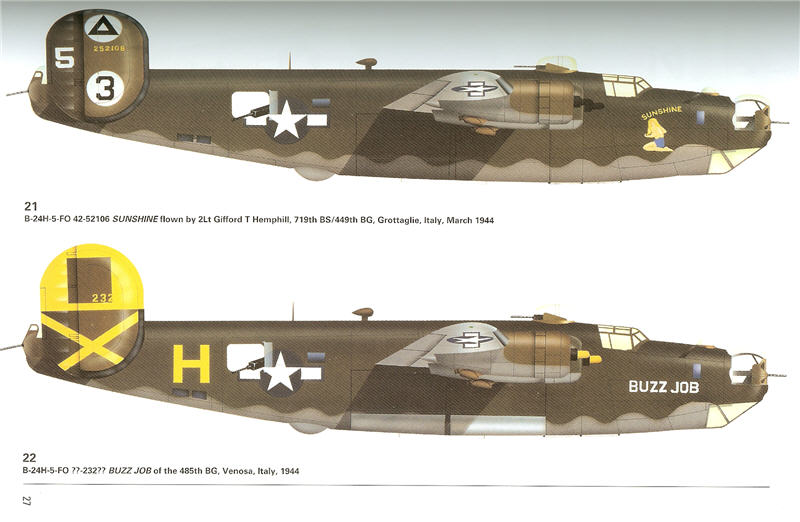
From B-24 Liberator Units of the Fifteenth Air Force, by Robert F. Dorr.
This seems to match the following WWII pictures of Witchcraft up to about mission 100.
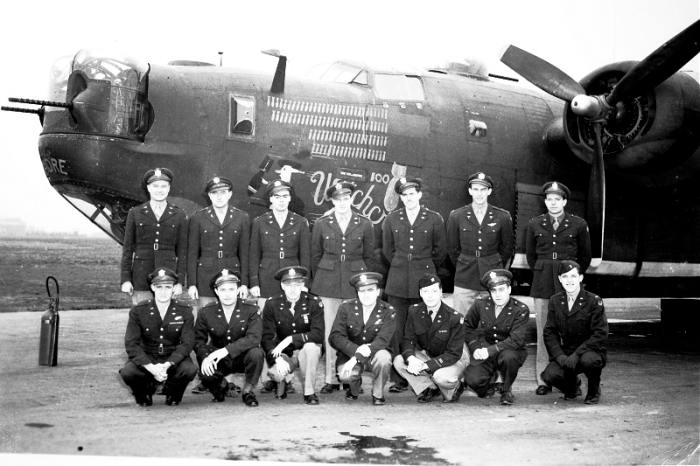
Officers of Squadron Administration of the 790th BS next to Witchcraft around
its 100th mission. Note inboard left engine cowling. It seems to have the same
coloration as the rest of the plane except for underneath, which seems like
it might be the gray color.

Another picture of Witchcraft near mission 100. Again, engine cowlings seem
to be same color as the topside of the engine housings except for gray underneath.
But this changes after about 100-120 (or more) missions. According to Fred Holdrege, CO of the 790th BS, in an e-mail to me: "The cowlings varied at time after engine changes. The cowlings were taken along with replacement engines and put on Witchcraft. They did not bother to repaint them." This is visible in pictures well after mission 100, such as the following.
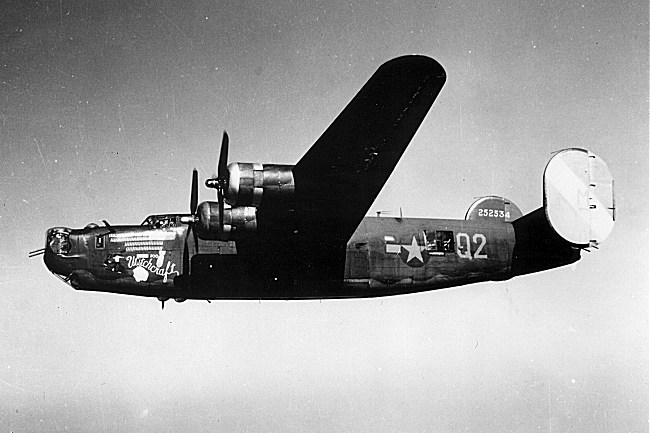
Witchcraft (judging from bomb symbols) sometime in the the range of 110-120
(or more) missions. According to Ray Betcher (in an e-mail to me), the tail
numbers were yellow, the prop tips were yellow, and the "Q2" on the
side was the same gray as the underneath of Witchcraft.
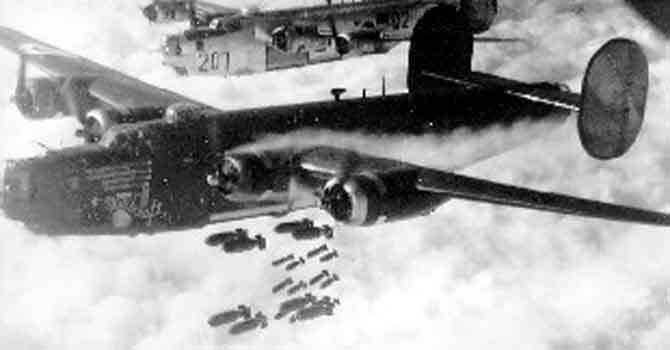
Witchcraft in action (judging from bomb symbols) sometime beyond 120 missions.
Some have judged this to be the following coloration -- i.e., engine cowls respectively of color red, white, red, and white, with white cowl flaps.
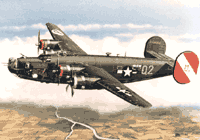
However, according to a September 13th , 2008 e-mail from Janice Bates, daughter of Ray Betcher (Witchcraft mechanic): "I talked to Dad this morning -- he says the Witchcraft cowlings were originally the 'olive drab' color of the plane. As engines were replaced, they may have gotten ones that were that color or unpainted (silver), but they NEVER had any that were red. He says he does have a picture of the Witch that has some of each color."
Thus, the bright cowl and cowl flaps are unpainted aluminum (not white); and the darker cowls, although a different shade perhaps because they came originally from another aircraft, are presumably still olive drab (not red).
For 100 missions or earlier, it seems that olive drab with gray underneath is the correct engine-cowl color. For 120 missions and higher, it seems that a combination of olive drab cowls and aluminum cowls, all with aluminum cowl flaps might be a good depiction.
Witchcraft had a wave-like boundary between the upper olive-drab coloring and the lower gray coloring.
Prior to about 65 missions, the wavy boundary ran across the bomb-bay doors as well, as is visible in these two historical pictures.
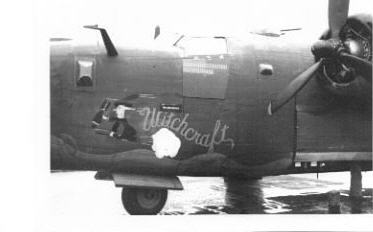
Witchcraft prior to about 40-50 missions. The wave boundary is visible on the
bomb-bay doors.
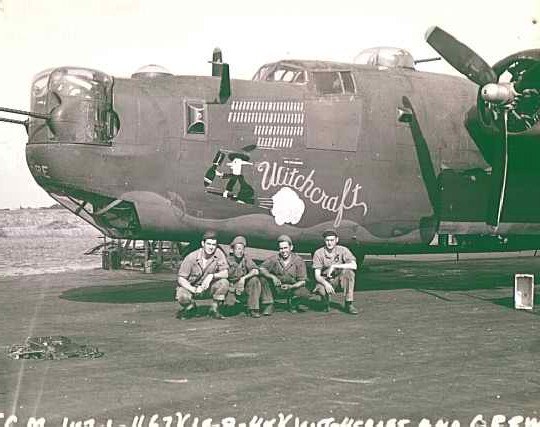
Witchcraft at about 65 missions. The wave boundary is visible still on the bomb-bay
doors.
However, after at least about 93 missions, the boundary across the bomb-bay doors seems to be straight, dispensing with the wave. This is how it is in numerous pictures up to and including retirement of Witchcraft.
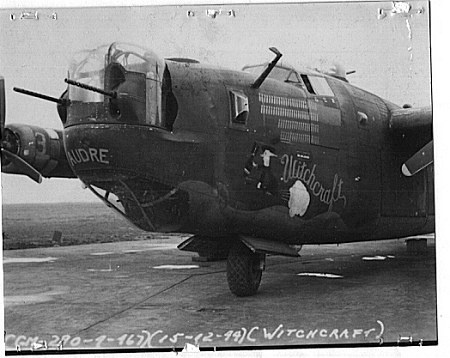
Witchcraft at about 93 missions.
Witchcraft has white stripes at the bottom edges of the bomb-bay doors. These are visibible in pictures from the early times until the end (mission 130). When the bomb-bay doors are closed, these white stripes would be along the bottom of the aircraft.

Witchcraft and 790th BS staff around the time of the 100th mission. The white
stripes are visible on the bottom edges of the open bomb-bay doors. Fred Holdrege,
CO of the 790th BS (middle of front row), provided much useful information and
contacts in the creation of this document.
The control surfaces of Witchraft are a slighly lighter color (except for the tail's red and white portions, it seems), as seen in early and late photographs. Also, there was a "circle P" on the top right wingtip.

In flight, showing lighter olive drab on inside right rudder than on inside
right vertical stabilizer.
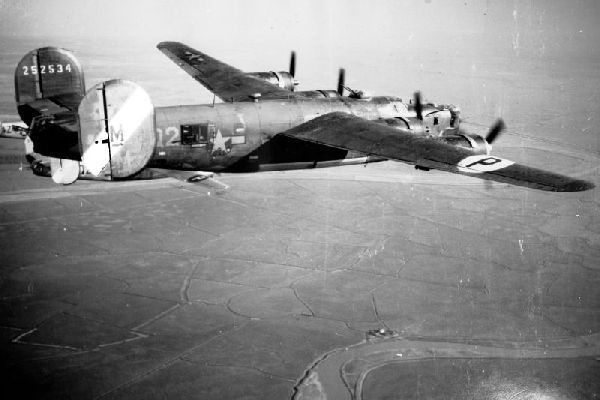
In flight, showing lighter olive drab on ailerons and elevators than wings and
horizontal stabilizer. This also shows the circle P on right wingtip.
According to Ray Betcher (from an e-mail to Brooke Anderson), Witchcraft had a yellow "3" painted on the inside of the right, outboard engine housing (so that it was easier for the top-turret gunner to get bearings). The Collings Foundation B-24 has a "9" also painted on the inside of the left, outboard engine housing, but historical photographs do not seem to show the "9".

"3" is visible to the left in the picture, on the right, outboard
engine housing. December 15, 1944 is after the 93rd mission.
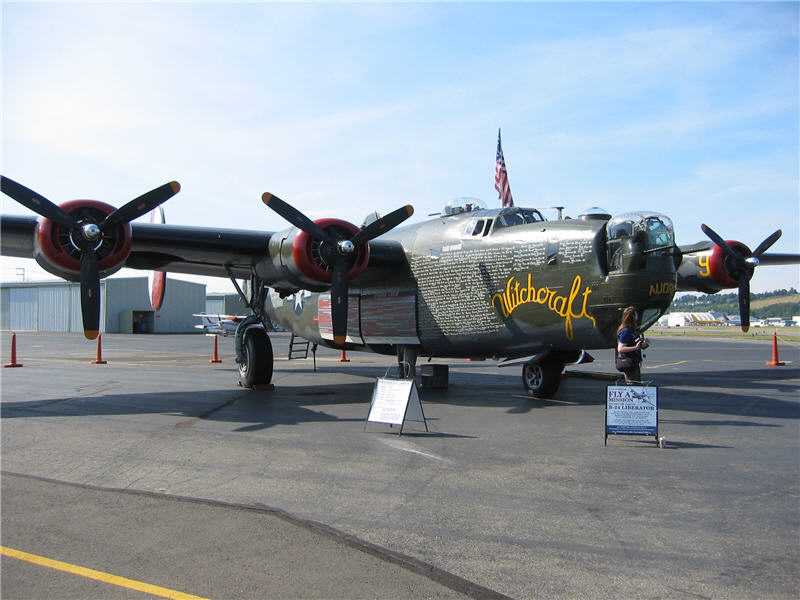
The Collings B-24, with "9" visible on left, outboard engine housing.
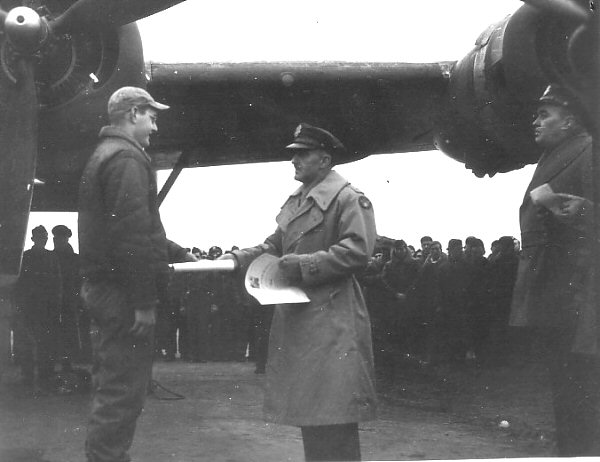
Raymond Betcher (mechanic, left) receiving award from General Kepner (right)
upon Witchcraft's 100th mission. There does not seem to be a "9" on
the left, outboard engine. Mr. Betcher provided much useful information in the
creation of this document.
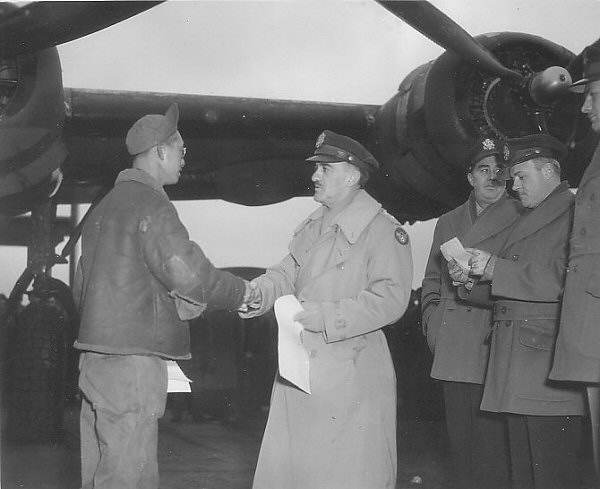
George Dong (assistant crew chief, left) receiving award from General Kepner
(right) upon Witchcraft's 100th mission. There does not seem to be a "9"
on the left, outboard engine.
The inside bottom half of the vertical stabilizers and rudders seem to be painted gray in various photographs from different times.
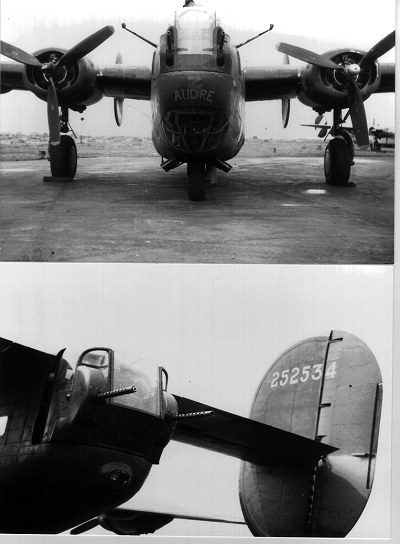
Picture showing gray in inside, bottom half of vertical stabilizer and rudder.
Also shows "AUDRE" on nose (painted in yellow on Collings B-24).
If anyone spots errors in any of my conclusions above, please feel free to contact me via my e-mail address given below.
v1, 9/15/2008
-- Original version of this document.
v2, 9/16/2008
-- Added information from Ray Betcher on color of engine cowls.
-- Revised introductory paragraphs.
-- Added information on lack of "9" on left engine.
v3, 9/21/2008
-- Added information about contributions of Fred Holdrege and Ray Betcher.
v4, 10/4/2008
-- Added additional information from Ray Betcher.
by Brooke P. Anderson
e-mail: brooke@electraforge.com
Click here to go back to the
main page.